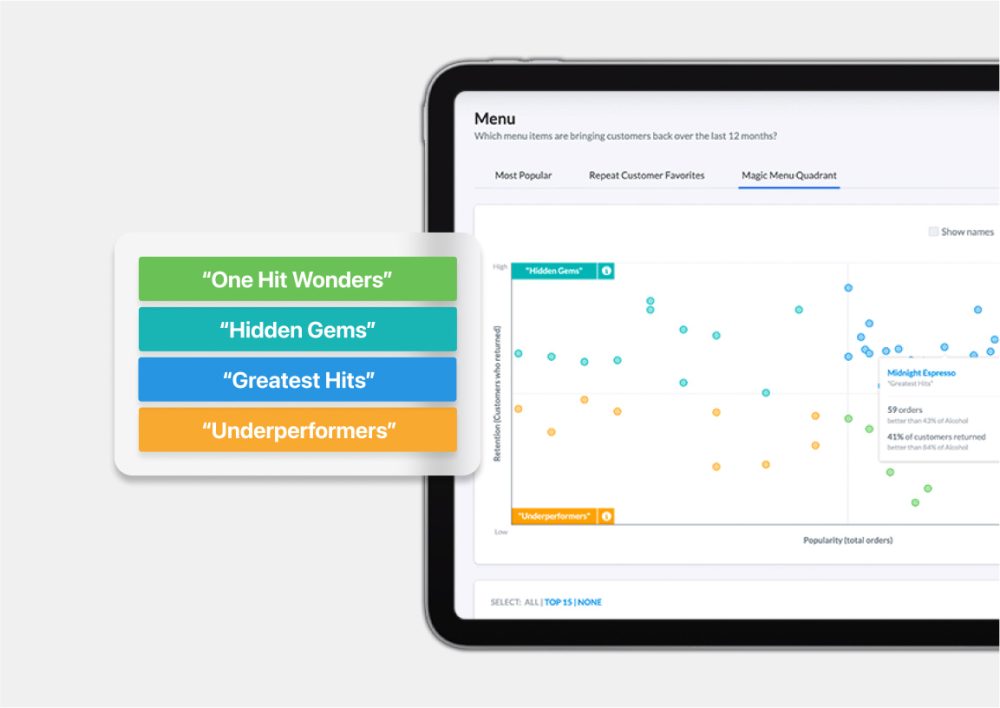
Vegan and plant-based eating has seen a dramatic increase over the past few years and shows no signs of slowing down. Vegans and health-conscious omnivores all over the world are demanding more from a vegan restaurant menu than the caesar-salad-no-bacon-no-dressing of yesteryear. As the popularity of veganism and plant-based fare continues to rise, the restaurant industry needs to respond with a plan of action to meet diners’ changing demands.
From a profitability perspective, introducing vegan menu options makes sense; if your restaurant can rise to meet the growing demand for plant-based alternatives, you’ll cater to a wider market. And that means a greater market share and a stronger bottom line. If you’re looking for vegan menu ideas to cater to this ever-growing population but don’t know where to start, we’ve got you covered.
In this article we’ll go over:
- Vegan menu: restaurant trends and statistics
- Benefits of adding vegan menu options
- 5 tips for adding vegan menu options
- Vegan menu ideas for your restaurant
- Refining your vegan restaurant menu
- Using data to optimize your menu
Need help with food costing?
Lightspeed’s food cost calculator breaks down your menu by dish and factors in each ingredient to find the desired margin for your restaurant.
Vegan menu: restaurant trends and statistics
The Economist declared 2019 ‘The Year of the Vegan,’ and the number of people choosing the vegan lifestyle has only increased since then. According to recent data from the Plant Based Foods Association:
- Plant-based food sales grew 6.6% in 2022, up from 5.9% in 2021, to $8 billion.
- The most popular plant based products are milk alternatives ($2.6B), meat replacements ($1.4B) and coffee creamers ($516M).
- 42% of the total US population plans to add more plant-based foods to substitute for animal-based foods, and 27% plan to eat less animal-based food in the future.
- 70% of the total U.S. population is consuming plant-based foods, up from 66% one year ago.
- Plant-based milk is becoming a household staple with 40.6% of U.S. households purchasing plant-based milks.
- While the overall average retail price of animal-based foods increased by 15%, plant-based foods increased only 10%.
Benefits of adding vegan menu options
Incorporating plant-based and vegan menu options into your restaurant menu isn’t just a nice thing to do for your customers and the planet, it’s also a smart business move. Here are a few things that adding vegan menu options can help you do, and why it’s a busy-savvy decision:
- Attract new customers: adding plant-based menu options to your menu will attract a larger customer base, including vegetarians, vegans, omnivores looking for healthier options, diners with dietary restrictions (such as those related to dairy or lactose) and even diners adhering to religious dietary restrictions at certain times of the year.
- Retain customers: people’s tastes and priorities change—even your most meat-centric customers could decide tomorrow to eat healthier or reduce their environmental footprint. If your menu doesn’t accommodate them, they’ll have no choice but to look elsewhere.
- Reduce food costs: plant-based ingredients are often cheaper than animal products, which can help you keep food costs under control. Compare, for example, a bag of lentils retailing at $0.33 /100g to chicken thighs at $1.87/100g.
- Get more group bookings: group organizers will often ignore restaurants that don’t have something for everyone. Having a variety of vegan menu options will increase your chances of getting more large group bookings.
5 tips for adding vegan options to your menu
As the list of diets and food restrictions grow—dairy-free, gluten-free, pescatarian, vegetarian, flexitarian and, of course, vegan amongst others)—it’s no wonder some restaurants are questioning whether it’s even possible to satisfy everyone. Here are a few tips that can help make it easier to get started on your vegan restaurant menu.

1. Do your research
Before diving into the realm of vegan offerings, it’s important to understand the nuances of plant-based cuisine. Instead of focusing on what vegans don’t eat, think about all of the great food and ingredients they do eat. From tofu to jackfruit, the vegan diet is diverse and exciting.
In addition to eliminating animal products, veganism emphasizes wholesome, plant-derived ingredients. To offer the best value to vegan customers, as well as omnivores who want to explore more plant-based fare, your vegan dishes should offer a good balance of protein, vitamins and flavor.
2. Start gradually
Rather than overhauling your entire menu overnight, consider introducing vegan menu options gradually. This will allow your kitchen staff to adapt to new ingredients and cooking techniques while your customers explore your plant-based offerings. For example, you could quickly add a veggie burger to your menu by buying the veggie patties wholesale—there’s no need to wait until you’ve perfected a signature veggie burger.
From portobello mushroom patties to black bean galettes, there are tons of great commercial veggie burgers on the market today. Try adding a high-quality vegan cheese to your food order so your customers can make it a vegan cheeseburger. Using a restaurant POS with advanced insights, you can track how your vegan menu items are performing and make adjustments to your menu as required.

Magic Menu Quadrant – Lightspeed Advanced Insights
3. Get familiar with vegan alternatives
When you’re ready to start making your vegan dishes in-house, there are many ways to creatively replace animal products with plant-based alternatives. There’s a common misconception that vegan food is more expensive; in reality, vegan dishes often cost less to produce than a high-quality meat equivalent of the same size.
For vegan ingredients that are more expensive than their non-vegan counterparts, such as some vegan cheeses, Lightspeed’s POS and restaurant management platform lets you add product modifiers—or “sub-items”—and give them any price you want. So, using a veggie burger as an example, you could create a veggie burger main item and then create sub-items for, say, regular cheese, swiss cheese and vegan cheese, each with individual prices so you don’t lose money on your vegan alternative.
| Replace this… | …with this |
| Ice cream | Sherbet or soy or coconut-based alternatives |
| Yogurt | Soy, rice or coconut-based alternatives |
| Cow’s milk | Milk from nuts (cashews, almonds), soy, rice, coconut or oats |
| Cheese | Nutritional yeast or soy or nut based alternatives |
| Honey | Agave nectar, maple syrup or coconut nectar |
| Eggs (in baking) | Ground flaxseed, bananas or applesauce |
| Meat | Tofu, seitan, tempeh, texturized vegetable protein (TVP), quinoa, beans, lentils, jackfruit or meat replacement alternatives |
4. Explore different cuisines
Foods from other cultures can be a great source of inspiration. In many countries and cuisines, it’s the vegetables, grains and legumes that take center stage. In India, for example, where roughly 40 percent of the population is vegetarian, you’ll find dozens, if not hundreds, of delicious vegan-friendly dishes. Ethiopian, Burmese and Mediterranean cuisines, among many others, also offer a tremendous variety of plant-based fare.
Familiarize yourself with the different ingredients and techniques that other cuisines have to offer, and experiment with different flavors and textures. You’ll be sure to get better results and have more fun doing it.
5. Consider certified ingredients
Currently, the FDA does not regulate whether a vegan product is actually vegan; the onus is on the restaurateur to set their own standards and source ingredients accordingly. The American Vegetarian Association’s certification program is one way to move ahead with confidence that both the product and the manufacturing process are free of animal by-products. It’s possible your food costs may increase slightly, but as more and more diners are becoming conscious and critical of the foods they eat, backing up your vegan restaurant menu with certification is a simple and surefire way to earn and keep your customers’ trust.
Vegan menu ideas for your restaurant
Breakfast

Photo by Saymom Leão on Unsplash
Many breakfast and brunch menus rely heavily on eggs and meats like bacon and breakfast sausages. Here are a couple of easy vegan breakfast options you can incorporate into your menu:
Tofu scramble
A vegan alternative to scrambled eggs, tofu scramble is quick and easy to make, high in protein, light on ingredients and customizable so you can make it your own. Make with as little as firm to ultra-firm tofu, or boost flavor and creaminess with plant-based milks, nutritional yeast and your spices of choice. Once you’ve got your tofu scrambled down, you’ve got the vegan foundation you need to make, say, a mouth-watering vegan breakfast burrito.
Avocado toast
Avocado toast is a simple, cost-effective and delicious way to cater to your vegan and health-conscious customers alike. Higher in protein than most other fruits, fresh avocados are a creamy and delicious addition to your vegan restaurant menu and an excellent source of vitamins and minerals. To make this really special for your diners, why not top it off with some tofu scramble, fresh tomatoes or vegan cheese?
Entrees

Photo by Weronika Krztoń on Unsplash
Some entrees are easy to make vegan by substituting real meat with substitutes like Beyond Beef® or Beyond Chicken®—but there’s no need to have meat, fake or otherwise, in your entrees. Here are a couple ideas for delicious, cost-effective vegan entrees built around vegetables and legumes.
Moroccan-style chickpea stew
In this hearty and flavorful dish, the humble chickpea takes center stage. Super versatile, affordable and high in protein and minerals, chickpeas are a growing presence in fast-casual and fine dining restaurants. Moroccan-style chickpea stew is typically loaded with hearty vegetables like squash and sweet potato and warm spices, such as ginger and cinnamon. Moroccan chickpea stew is easy to make, stores well (dried, canned and in your walk-in after cooking), is infinitely customizable and won’t blow your food budget.
Cuban-style black beans and rice
Like chickpeas, black beans are a cost-effective and versatile ingredient you can build your vegan menu options around. From veggie burger patties to protein-packed quesadillas, mastering this humble and healthy legume will put you ahead of the game. Cuban-style black beans are slow cooked, packed with smoky, rich flavor and spice. They can be served with a simple side of rice and topped with fresh herbs, or elevated with a side of fried okra, collard greens, a sweet and savory cornbread or whatever makes sense to you.
As with any new menu item, it’s important to familiarize yourself and your staff with any new or different food safety procedures that need to be taken to ensure vegan menu options are prepared, cooked and stored safely.
Refining your vegan menu options
So, you’ve consulted, created and certified. The vegan additions to your menu are looking and tasting great. What happens next?
Get feedback from your staff and customers
Never underestimate the value of employee feedback. It’s a good idea to involve your employees, both front and back of house, in the development of your vegan menu options. Your back-of-house staff may have valuable insights or experience preparing vegan dishes that you don’t know about. Your front-of-house team may have important insights to share about what customers have been asking for.
Once your vegan dishes are circulating, you’ll want to know how they’re being received by guests. Check in frequently with your staff during this stage. Consider coaching your wait staff on how to ask clarifying questions—tactfully, of course—if and when a guest gives negative feedback so you can better understand what can be improved.
Of course, you don’t have to wait for your guests to complain to ask for feedback. Create an open dialogue and let your guests know that you really want their ideas and feedback. You’ll get valuable insights while simultaneously communicating your commitment to providing the best possible value to your guests.
Get the word out
Once you’re happy with your vegan dishes and are ready to go public, it’s time to get the word out. We recommend:
- Throwing a menu release party where new and existing customers can sample your new vegan menu options.
- Promoting your new plant-based menu on your website and social media channels.
- Updating your digital touchpoints (places like Google My Business, TripAdvisor, Yelp, etc.) to highlight the fact you now carry vegetarian and vegan fare.
Keep in mind that your customers don’t have to identify as vegan to enjoy tofu pad thai or veggie pakoras. Language is a big consideration when marketing plant based foods. Finding out whether your audience is more receptive to “plant-based” than “vegan” or “meat-free” will help you roll out an effective campaign that will resonate with more potential customers.
Using data to optimize your menu
Using a restaurant POS with advanced insights, you can see which menu items are performing best, which ones might need a bit more promotion and which ones need to be adjusted or cut from the menu altogether.
With Lightspeed’s product reports, I can see what products are selling or not selling. We have a small space and a small kitchen, so we have to keep our menu small to stay in control. Everything has to be streamlined. If something isn’t selling enough, it doesn’t stay on the menu. — Brodie Somerville, Owner & Chef, Maynard
Ready to get started with the one-stop restaurant management platform that can help you with menu management, inventory control and more? Talk to one of our experts about how Lightspeed can help.

News you care about. Tips you can use.
Everything your business needs to grow, delivered straight to your inbox.


